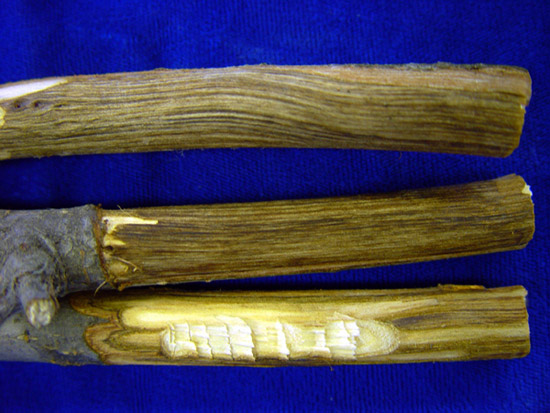Issue 9, June 18, 2010
Dutch Elm Disease or Elm Yellows?
There are still many elms in Illinois. When one starts to decline, most of us suspect Dutch elm disease (DED). This disease is well known for causing the death of most American elms in the state. Some think it kills "Dutch elms," but there is no such elm. The disease is named Dutch elm disease because it was first found in the Netherlands (in 1921). It moved to the US in the 1930s. There are two species involved, Ophiostoma ulmi (formerly known as Ceratocystis ulmi) and Ophiostoma novo-ulmi. The first fungal species killed elms through the 1970s. The second species is more aggressive and caused a second wave of infection starting in the 1970s. We can identify DED at the Plant Clinic by culturing live, symptomatic wood. We cannot differentiate these species.
Check out RPD No. 647 (Adobe PDF) for more on DED. In Illinois, most new infections are first observed during June, so you might see problems now. Leaves on one or more branches wilt, turn dull green, yellow, then brown, curl, and usually drop prematurely. Most elms usually die in one year, but large elms die slower, sometimes over two or more years. The most diagnostic symptom is vascular streaking as seen in the image. This streaking will appear immediately when bark is peeled. If the streaking appears after exposed to air for a few minutes, that is not caused by the DED fungus. Verticillium wilt can also cause streaking, as can some canker diseases. Cultures from live wood showing vascular streaking will produce sporulation, allowing a positive identification in as little as 5 days.

Elm Yellows can cause elms to decline and die too. The symptoms are a bit different but easily confused with those of DED. Elm yellows is also called Phloem Necrosis because the causal pathogen kills the phloem. The first symptom is wilting. Foliage may be sparse in the spring with many yellow (not brown) leaves. The wood is not streaked as with DED but the inner bark turns tan or butterscotch in color and has a wintergreen odor. A report on plant disease discussing elm yellows can be found on-line.
The pathogen causing elm yellows is a phytoplasma. Although similar to a bacterium, phytoplasmas cannot be cultured in the lab. They can be identified through PCR and further testing, not yet available at the University of Illinois Plant Clinic. Private testing labs such as Agdia, Inc can provide this service. The cost can be prohibitive to some clients. Consider eliminating DED as a possibility through standard lab culturing. Consult the University of Illinois Plant Clinic web site, for details on how to send a sample for testing. Here is a link to a very helpful USDA pamphlet, How to Differentiate Dutch Elm Disease From Elm Phloem Necrosis.--Nancy Pataky
Author:
Nancy Pataky